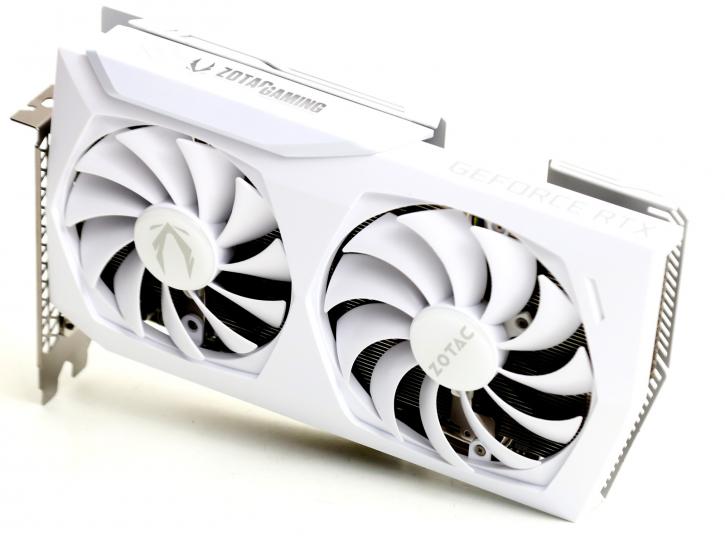Introduction
ZOTAC GeForce RTX 3060 AMP White Ed. review
We travel to the bases of ZOTAC, which released a compact-sized AMP GeForce RTX 3060, also with 12GB, 3584 shading processors activated and with a default boost clock of 1867 MHz the OC edition graphics card has been tweaked straight out of the box for you and our tested model, comes in a white design.
With that 3584 shading cores and Ampere architecture, this 3060 series is bound to impress in the 2560x1440 (WQHD) domain. If we look back at the previous generation, the product would sit at GeForce RTX 2070 (SUPER) performance levels and, in due time, will replace that series. If stock becomes available in plentiful volumes though. The GPU is again fabricated on an 8nm node derived from Samsung. This process further develops Samsung's 10nm process; no EUV is applied in production just yet. The first wave of announcements has seen the GeForce RTX 3080 and 3090 being released first, and, as a bit of a surprise, the GeForce RTX 3060 Ti and 3070. It's now late February 2021 and NVIDIA is set to release its more 'regular' 3060 prices 329 USD. As you will have noticed, the 3060 GPU cores count is about 26 percent lower than with the RTX 3060 Ti, which has a GA104 chip with 4864 shading cores (shader/stream/cuda cores = all the same thing with a different name). NVIDIA is launching the 3060 series with the 12GB model, which's remarkably enough is 2GB more than the GeForce RTX 3080 (!). Later on, they'll likely silently slip in a 6 GB version, though that has not been confirmed. NVIDIA advertises the series with 13 'shader teraflops' and 25 'RT-ops', the latter giving an indication of the ray-tracing performance. Notable is that a change is in effect, the memory runs ar 15 Gbps as opposed to the usual 14 Gbps, likely to compensate for the perf hit of going 256-bit towards 192-bit on the memory bus due to that memory configuration. It's the same for the shader core cluster, it's clocked higher in the boost frequency compared to the Ti model, also compensating a bit for the lower number of shader cores.
The Ampere lineup nearly doubles ray-tracing performance with Gen2 ray-tracing cores and 3rd iteration Tensor cores. These cards will all be PCIe 4.0 interface compatible and offer HDMI 2.1 and DisplayPort 1.4a, but most importantly is that exorbitant shader processor count (referred to as CUDA cores by NVIDIA). With just over a third of the shader processor count seen from the flagship product, we now meet the NVIDIA GA106 GPU. And despite being a lower segmented card, it still holds a sizable GPU die. In this round, NVIDIA is not seeding Founder edition cards, aka FE GeForce RTX 3060. But of course, they do present the reference specification; a boost clock of 1780 MHz and a base clock of 1320 MHz.
| Model | Base Clock (MHz) | Boost Clock (MHz) | VRAM Base Clock (MHz) | VRAM Effective Datarate (MHz) | Max Power % |
| GeForce RTX 3060 | 1320 | 1780 | 1875 | 15000 | - |
| ASUS RTX 3060 STRIX OC | 1320 | 1882 | 1875 | 15000 | 23 |
| PALIT RTX 3060 DUAL OC | 1320 | 1837 | 1875 | 15000 | 6 |
| MSI RTX 3060 Gaming X TRIO | 1320 | 1852 | 1875 | 15000 | 6 |
| EVGA RTX 3060 XC | 1320 |
1882 |
1875 | 15000 |
12 |
| ZOTAC RTX 3060 AMP Wh. | 1320 |
1867 |
1875 | 15000 | 10 |
ZOTAC GeForce RTX 3060 AMP White 12G
ZOTAC as well submitted a sample for review. This round they've send out the AMP edition in the color white. The cooler shall and backplate are white, albeit the backplate has a bit of a yellowish tint through it. As you can see the dual-fan spinner design makes the card really compact. Based on an advertised 170W TGP the card is of course paired with 12GB GDDR6 graphics memory at 192-bit running at 15 Gbps. It is a more simplified-looking product that comes with a decent factory tweak, making it perform a few percent above reference/baseline performance. Dual refers towards the cooler with its duo of spinners. The card has two (6+2) pin power headers, unfortunately, tucked away deep inside the cooling bracket, which makes them difficult to access. Armed with a BIOS that offers an 1867 MHz Turbo (1780 MHz = reference). Let's have a look at how well the product performs.


